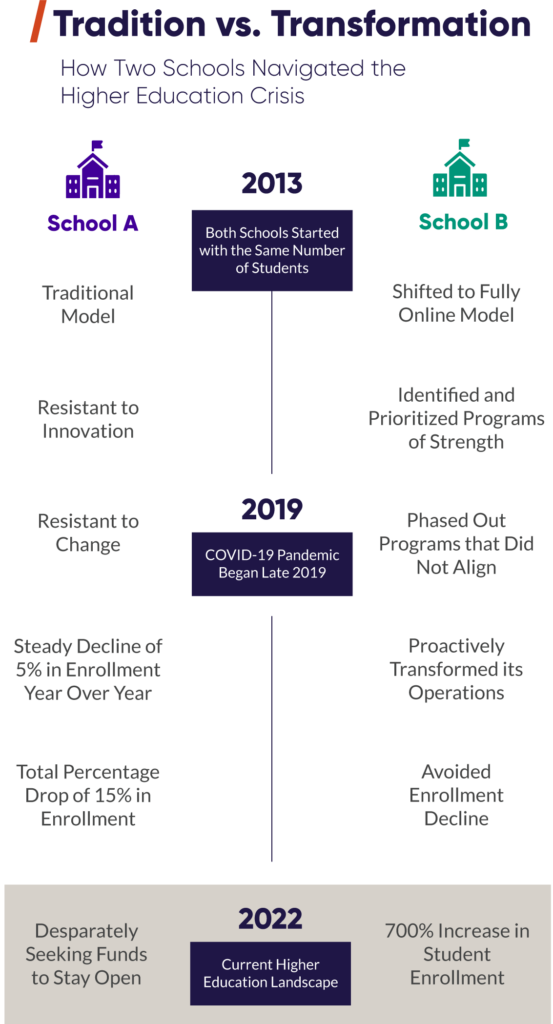The Rise of Private 4-Year School Closures: Solutions to a Widespread Crisis

Why Private 4-Year Schools Are Closing
In recent years, the higher education landscape has witnessed a troubling trend: the increasing closure of private 4-year institutions. Let’s look over the past thirty years of official school closures across the higher education landscape, comparing public and private data from the beginning of the 1990s. Between 1990 and 2017, school closures of private universities held steady at an average of 6 schools per year. A fairly high number when you step back and realize how many institutions that represents. However, it is nothing to the past five years (to 2022, the latest data this study held), which ballooned to a whopping 18 per year, in other words a 190% increase!
The Devaluing of a Higher Education
Why is this happening? This phenomenon has been fueled by a combination of factors, including changing perceptions of the value of a traditional college education, the impact of the COVID-19 pandemic and recent policy changes affecting financial aid. As we delve into this issue, it becomes clear that these closures represent more than just isolated incidents – they signal a broader crisis facing the entire higher education sector.
One of the key reasons behind the closure of private 4-year schools is the shrinking market of individuals who perceive a four-year degree as valuable. With the rising cost of tuition and concerns about student debt, many prospective students and their families are questioning whether the investment in a traditional college education is worth the investment. According to our recent Benchmarks report, 66% of Americans believe that schools are “stuck in the past” and do not meet current needs. Additionally, 45% of companies are planning to remove the need for a bachelor’s degree for at least some of their positions.
This shift in attitudes has led to declining enrollment rates at many private institutions, putting pressure on their financial viability. Given their generally higher tuition costs, and reliance on that tuition revenue, they are seeing the brunt of this change in attitude.
The Impact of COVID-19 on Private Colleges: A Turning Point
The COVID-19 pandemic exacerbated and combined with the growing trend of devaluing a college degree by disrupting traditional on-campus programs and causing a significant drop in enrollment over the two to three years that saw the highest impact of Covid closures. With fewer students willing or able to attend in-person classes, these institutions faced a challenge towards shifting to an online model.
While many schools did find success with a rapid online infrastructure (or had the foundations of one already built), other schools relied on mass zoom calls, and reduced online availability as classes opened up. In speaking with a variety of institutions who saw this series of events play out, they cited an increase in the strategy as a concession to campus faculty, who preferred an on-campus environment as a whole.
Furthermore, the introduction of the new FAFSA (Free Application for Federal Student Aid) has added another layer of complexity to the situation. Some schools have reported a drastic decrease in FAFSA submissions, with numbers plummeting by as much as 40%. This decline in financial aid applications further strains the already precarious financial positions of many private institutions.
The 2025 Enrollment Cliff
Adding to the challenge is the impending 2025 enrollment cliff, which will see a significant decrease in the number of 18-year-olds entering college. This demographic shift will further shrink the pool of potential students, making it even harder for struggling institutions to maintain enrollment levels and revenue streams.
How Private Colleges Can Thrive in a Changing Landscape
In the face of these daunting challenges, it’s essential for private 4-year institutions to adapt and find new ways to thrive. Let’s consider the contrasting paths taken by two schools, both of which started with the same number of students in 2013. One, School A, clung to its traditional model, resisting innovation and viewing change as a threat. The other, School B, embraced a spirit of experimentation, investing in new programs, technologies and partnerships to attract and engage students in a rapidly evolving world. This stark contrast in approaches will highlight the crucial role of adaptability in ensuring long-term success in higher education.
How School B Embraced Change
School A chose to maintain its current trajectory without making significant changes. As a tuition-driven private institution, they were not experiencing growth, but they were not declining either. Since they had experienced decades of stable enrollment, there was not a drive from leadership to make any alterations to their strategic plan. As a result, the aforementioned challenges facing higher education caused a steady decline of an average 5% in enrollment year over year from 2019-2022 which resulted in a total percentage drop of 15%, and they are now facing financial difficulties. With a shrinking student population and dwindling resources, School A is desperately seeking funds to keep its doors open.
On the other hand, School B took proactive measures to transform its operations and address the changing landscape of higher education. Under new executive leadership, they identified and prioritized its programs of strength while phasing out those that no longer aligned with its mission or were underperforming.
Recognizing the growing demand for online education, School B made a strategic shift to a fully online model and invested in marketing and enrollment management by partnering with EDDY to attract more students, allowing it to reach students wherever they are and provide flexibility in their learning options. By embracing innovation and adapting to the needs of modern learners, School B not only avoided decline but flourished, experiencing a 700% increase in student enrollment by 2022.

The Power of Partnership in Driving Enrollment Growth
The example of School B demonstrates that it is possible for private 4-year institutions to overcome the challenges they face and thrive in today’s higher education landscape. By embracing change, investing in marketing and technology, and focusing on their core strengths, these schools can position themselves for growth and sustainability.
However, achieving this transformation requires a concerted effort and a willingness to rethink traditional approaches to education. Schools must be proactive in identifying and addressing the factors contributing to their decline. This involves restructuring academic programs, investing in online learning infrastructure, and, most importantly, building student-centered experiences from initial engagement through graduation.
The example of School B demonstrates that it is possible for private 4-year institutions to overcome the challenges they face and thrive in today’s higher education landscape. However, achieving this transformation requires more than just internal changes. Collaboration and diversification are essential for long-term success. School B, for instance, recognized the power of partnerships by collaborating with EDDY to enhance its marketing and enrollment management. This type of collaboration allows institutions to share resources and expertise, expanding their reach and offering students more diverse educational opportunities.
Diversifying Revenue to Secure the Future of Private Education
Furthermore, School B’s success demonstrates the need for financial diversification. While tuition revenue remains vital, private institutions must explore alternative sources of funding to ensure long-term stability. This could involve seeking philanthropic donations, research grants, or corporate partnerships. Innovative financing models, like income-share agreements, could also make education more accessible and affordable for students, potentially attracting a broader demographic.
The increase in private 4-year school closures over the past five years is a complex issue driven by a combination of factors. While the 2025 enrollment cliff has taken most of the spotlight, this issue will not be the only challenge that institutions face – or even the most important. By taking proactive steps to adapt to these challenges, institutions can not only survive but thrive in the face of adversity. It’s imperative for schools to learn from successful examples like School B and embrace innovation to ensure a vibrant future for higher education.